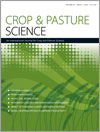Application of film antitranspirant to wheat during late stem extension reduces drought damage to yield, but the mechanism is unknown. Field experiments under rain shelters were conducted over 3 years to test the hypothesis that film antitranspirant applied before meiosis alleviates drought-induced losses of pollen viability, grain number and yield. The film antitranspirant di-1-p-menthene was applied at third-node stage, and meiosis occurred at the early boot stage, with a range of 11–16 days after spray application in different years. Irrigated, unsprayed plots were included under the rain-shelters, and pollen viability, measured in 2 years in these plots, averaged 95.3%. Drought reduced pollen viability to 80.1% in unirrigated, unsprayed plots, but only to 88.6% in unirrigated plots treated with film antitranspirant. Grain number and yield of irrigated plots, measured in all years, were 16 529 m–2 and 9.55 t ha–1, respectively, on average. These were reduced by drought to 11 410 m–2 and 6.31 t ha–1 in unirrigated, unsprayed plots, but only to 12 878 m–2 and 6.97 t ha–1 in unirrigated plots treated with film antitranspirant. Thus compared with unirrigated, unsprayed plots, antitranspirant gave a grain yield benefit of 0.66 t ha–1. Further work is needed to validate the pollen viability mechanism in different climatic zones and with a wide range of cultivars.
How to translate text using browser tools
19 February 2016
Evidence for improved pollen viability as the mechanism for film antitranspirant mitigation of drought damage to wheat yield
Minuka M. Weerasinghe,
Peter S. Kettlewell,
Ivan G. Grove,
Martin C. Hare
ACCESS THE FULL ARTICLE

Crop and Pasture Science
Vol. 67 • No. 2
February 2016
Vol. 67 • No. 2
February 2016
BBCH GS 33
pollen mother cells
polymer
water deficit
Water potential
water stress




